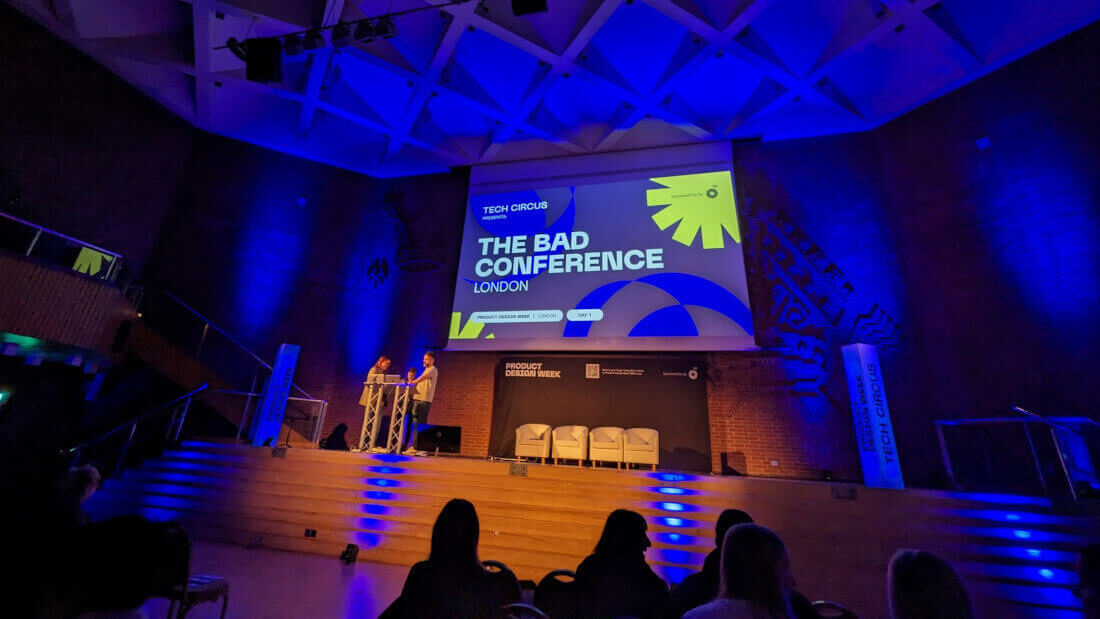I recently attended the brilliant Behaviour and Design (BAD) Conference 2023 and want to share some takeaways from a range of insightful talks.
The event was hosted by Tech Circus and, as a user researcher and behavioural scientist, it was absolutely perfect for me.
After tuning in to a few online sessions during the pandemic, the prospect of experiencing this conference live had me buzzing with excitement.
Throughout the day, I bathed in the wisdom of inspiring speakers who mapped academic expertise in psychology, anthropology, behavioural science, and cognitive science onto the realm of user research and design.
Let me tell you about the ones that resonated with me most, and maybe you’ll get inspired, too.
Where behavioural and social science meet design
The kick-off by Rosie Webster (PhD) from Zinc introduced the concept of ‘human social centred design’ (HSCD) which fuses behavioural and social science with human-centred design (HCD).
She championed the idea that incorporating existing knowledge and evidence about human behaviour into the design-led approach maximises engagement and effectiveness.
Rosie dished out practical insights on:
- Expediting secondary research with AI tools like Elicit and Consensus – have you checked them out yet?
- Integrating behavioural science models like the COM-B model for behaviour change into research and design.
- Using experimentation methods to gauge product effectiveness.
Rosie spoke directly to my behavioural-science-influenced-user-researcher heart and I loved meeting someone with the same background and passions as mine.
Remote versus in-person research
Adel Kalman from phone network EE shared illuminating experiences about remote versus in-person research, weighing the benefits of each.
Remote research, which currently constitutes 86% of user research, offers convenience, speed, diverse access, and cost efficiency.
However, in-person research captures valuable behavioural data, like non-verbal cues, often overlooked in remote interactions.
The key takeaway for choosing the right research mode boiled down to considerations like:
- interviewer involvement
- contact with the respondent
- locus of control
- privacy
- technology use
- available resources
- communication channels
My personal insight was that even though remote user research has become the gold standard in my work, it’s important to keep weighing the benefits and limitations of each method. And if more detailed behavioural data is important, such as during user testing, I should be more robust in advocating for in-person sessions.
Nudges: success or failure?
Razima Kadir (PhD) from J.P. Morgan delved into the world and history of using nudges in design, particularly in public interventions or political tools.
She argued that focusing on changing individual behaviour sidesteps broader underlying issues.
She believes this has led to the failure of recent interventions, such as the global response to COVID-19.
Instead of using nudges, Razima advocated for directing resources toward systemic changes, even if they might be slow, challenging, and expensive.
I agree with her view and don’t think nudges or behavioural interventions should be the sole focus of (political) leaders. They must not be mistaken for a quick and easy way out of large-scale systemic issues.
Having said that, I don’t think the right consequence is to stop researching and positively influencing individual behaviour.
Personally, I’m still glad, for example, that I knew how I could change my behaviour to protect myself and my family during the pandemic, rather than having to wait for the government to figure out how to stop the pandemic and protect everyone.
I believe that there is value and power in small changes, but we should be working on the big changes as well.
The era of behavioural personas
Elena Hill-Artamonova challenged the use of conventional user personas since they are often based on assumptions and over-generalisations. As a result, they are limited in predicting user behaviour.
Elena proposed an alternative – ‘behavioural personas’, crafted from diverse user research methods, identifying behavioural patterns, motivations, feelings, triggers, and expectations.
The result? Well-rounded, engaging personas that predict and influence user engagement.
I couldn’t agree more and think that these should be the main type of personas used as user research deliverables.
Behavioural design in cybersecurity
A particularly engaging and brilliant talk was delivered by Inka Karppinen PhD from Cybsafe.
She cautioned about the potential dangers when psychology and behavioural science fall into the wrong hands – hackers, to be precise.
Besides making quickly clear how easily manipulated we are as human beings, she highlighted how behavioural design could bridge the intention-action gap in cybersecurity.
For instance, by using the COM-B model to assess users’ capability, opportunity, and motivation to take the right cybersafe actions.
- Capability: Do they know how to recognise a phishing email? How to report it?
- Opportunity: Do they have the right resources like time to check if in doubt?
- Motivation: How confident and motivated are they to recognise and report a suspicious email?
Cults and the ethical limits of behavioural design
Patrick Fagan shared some fascinating learnings about the ethical boundaries of behavioural design, drawn from studying cults, marketing schemes, and websites.
In an entertaining twist, he showcased how behavioural science can be wielded for either unethical manipulation or, conversely, to boost user autonomy and control.
I think there is a fine line between the two and, as behavioural scientist, I consistently ask myself if what I do is ethical, and in the best interests of the user or consumer.
Patrick’s examples, however, showed that not every designer or leader does that, and as a consumer myself, I need to know how to detect such deceptive patterns of behavioural design.
‘Jobs to be done’: a focus on outcomes
Sabrina Dudas from StepStone unveiled the concept of ‘Jobs to be Done,’ pioneered by Tony Ulwick.
This approach focuses on understanding the outcomes users or clients desire and highlights the need to separate the development from the innovation process.
It emphasises the importance of comprehending user needs at different levels:
- visions and aspirations (high-level jobs)
- main goals (core jobs)
- smaller steps needed to accomplish them (lower-level jobs)
Integrating behavioural science in this concept involves researching and identifying users’ fears, triggers, motivations, barriers, and more, to ensure they ‘get their jobs done.’
This approach was totally new to me.
I should say that I briefly worked with Sabrina in a previous role and it was great to run into her at the conference. Meeting peers is half the fun!
AI in healthcare technology
Maura Bellio (PhD) rounded off the day with a talk tailor-made for nerds like me.
Walking us through the impressive project she undertook for her PhD, she explained how she and her team used AI to innovate healthcare technology.
Besides the tech aspects, Maura tackled the prevalent design-reality gap in healthcare that I have come across myself in my current work.
Often lagging behind other industries, healthcare technology fails to align with actual user needs, especially when those users are clinicians.
Maura highlighted the importance of transparency and ‘explainability’ over performance in AI solutions.
She emphasised that technical skills are often lacking among healthcare staff –understandably, because they have more important things to focus on. And also, that standard technical solutions are not useful, clear, or trustworthy to that audience.
Simplifying dashboards to show only crucial information, rather than overwhelming users with technical details of what the AI had done, proved instrumental in increasing adoption.
I loved this talk and hope to get a chance to work on an AI in health tech project myself someday.
Fired up and ready to go
The BAD conference left me brimming with inspiration, knowledge, and new connections, rekindling my passion for behavioural design.
I’m eager to apply these insights and can hardly wait for the next conference.



